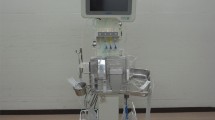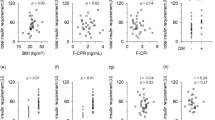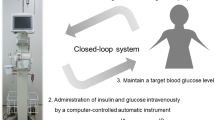Abstract
Objectives
Although strict blood glucose control during cardiovascular surgery is essential to avoid postoperative complications, the various changes in glucose levels that occur during surgery have not been investigated in detail. In this study, we continuously monitored blood glucose changes during aortic surgery using the STG-55Ⓡ artificial endocrine pancreas (Nikkiso Inc., Tokyo).
Methods
Between December 2015 and 2016, we performed continuous blood glucose monitoring in 22 patients (14 men and 8 women, 72 ± 11 years old), who required hypothermic circulatory arrest during an ascending/aortic arch surgery, at the Jichi Medical University Hospital. Ascending aorta replacements were performed in two patients and partial/total arch replacement, in 20. All the patients required selective cerebral perfusion and hypothermic circulatory arrest (bladder temperature at 25–26 °C) during distal anastomosis. Closed-loop continuous blood glucose monitoring was performed during cardiopulmonary bypass using the STG-55Ⓡ artificial endocrine pancreas (Nikkiso Co., LTD, Tokyo).
Results
Blood glucose concentrations did not increase significantly from the time of the commencement of cardiopulmonary bypass to lower body ischemia. However, they dramatically increased immediately after reperfusion following lower body ischemia, and this hyperglycemia was sustained until the end of cardiopulmonary bypass.
Conclusion
The current study clarified the peak glucose concentration during aortic surgery. These data may contribute to the management of blood glucose levels during aortic surgery.



Similar content being viewed by others
References
van den Berghe G, Wouters P, Weekers F, Verwaest C, Bruyninckx F, Schetz M, et al. Intensive insulin therapy in critically ill patients. N Engl J Med. 2001;345:1359–67.
Doenst T, Wijeysundera D, Karkouti K, Zechner C, Maganti M, Rao V, et al. Hyperglycemia during cardiopulmonary bypass is an independent risk factor for mortality in patients undergoing cardiac surgery. J Thorac Cardiovasc Surg. 2005;130:1144–50.
Shine TS, Uchikado M, Crawford CC, Murray MJ. Importance of perioperative blood glucose management in cardiac surgical patients. Asian Cardiovasc Thorac Ann. 2007;15:534–8.
Minakata K, Sakata R. Perioperative control of blood glucose level in cardiac surgery. Gen Thorac Cardiovasc Surg. 2013;61:61–6.
Tsukamoto Y, Okabayashi T, Hanazaki K. Progressive artificial endocrine pancreas: the era of novel perioperative blood glucose control for surgery. Surg Today. 2011;41:1344–51.
Kawahito S, Kitahata H, Kitagawa T, Oshita S. Intensive insulin therapy during cardiovascular surgery. J Med Invest. 2010;57:191–204.
Maeda H, Okabayashi T, Nishimori I, Yamashita K, Sugimoto T, Hanazaki K. Hyperglycemia during hepatic resection: continuous monitoring of blood glucose concentration. Am J Surg. 2010;199:8–13.
Carmichael FJ, Lindop MJ, Farman JV. Anesthesia for hepatic transplantation: cardiovascular and metabolic alterations and their management. Anesth Analg. 1985;64:108–16.
Shangraw RE, Hexem JG. Glucose and potassium metabolic responses to insulin during liver transplantation. Liver Transpl Surg. 1996;2:443–54.
Yatabe T, Kitagawa H, Kawano T, Munekage M, Okabayashi T, Yamashita K, et al. Continuous monitoring of glucose levels in the hepatic vein and systemic circulation during the Pringle maneuver in beagles. J Artif Organs. 2011;14:232–7.
Ungerstedt J, Nowak G, Ungerstedt U, Ericzon BG. Microdialysis monitoring of porcine liver metabolism during warm ischemia with arterial and portal clamping. Liver Transpl. 2009;15:280–6.
Kawahito S, Higuchi S, Mita N, Kitagawa T, Kitahata H. Novel blood sampling method of an artificial endocrine pancreas via the cardiopulmonary bypass circuit. J Artif Organs. 2013;16:508–9.
Author information
Authors and Affiliations
Corresponding author
Ethics declarations
Conflict of interest
Koji Kawahito and the other authors have no conflict of interest.
Funding
The author(s) received no financial support for the research, authorship, and/or publication of this article.
Rights and permissions
About this article
Cite this article
Kawahito, K., Sato, H., Kadosaki, M. et al. Spike in glucose levels after reperfusion during aortic surgery: assessment by continuous blood glucose monitoring using artificial endocrine pancreas. Gen Thorac Cardiovasc Surg 66, 150–154 (2018). https://doi.org/10.1007/s11748-017-0872-z
Received:
Accepted:
Published:
Issue Date:
DOI: https://doi.org/10.1007/s11748-017-0872-z




